Australia: There goes the neighbourhood
By Steve Keen, Associate Professor of Economics & Finance at the University of Western Sydney, and author of the popular book Debunking Economics (www.debunkingeconomics.com).
The last two days have seen the latest monthly data on credit growth in Australia from the RBA, and the latest quarterly data on house prices from the ABS. Together they confirm trends that I’ve identified on numerous occasions between the acceleration of mortgage debt and the change in house prices (see Hand of Gov report on the Australian Housing Bubble, A much more nebulous conception, The Chopping Block,Updated Credit Accelerators, House Prices and the Credit Impulse, This Time Had Better Be Different: House Prices and the Banks Part 1 & Part 2).
Housing credit increased by 0.5 per cent over September (see the RBA Release for details), but this involved a further deceleration of mortgage debt as Figure 1 shows.
Figure 1: Change and Acceleration of Mortgage Debt in Australia
As I explained in “A Much More Nebulous Conception“, there is a complex causal link between the acceleration of mortgage debt, and the change in house prices. In a nutshell, the two sources of monetary demand are income and the change in debt; these then finance the purchases of both newly produced goods and services, and the turnover of existing assets. There is thus a causal link flowing from change in debt to the level of asset prices, and consequently a link between the acceleration of debt and the change in asset prices.
That relationship is evident in the pattern of change in Australian house prices over the last two decades. the most recent figures—that prices fell 1.2% over the June to September 2011 quarter, and 2.2% from September 2010 to September 2011 (see the ABS Release for details)—confirm that mortgage debt acceleration, and not “population pressure” etc., is the key determinant of house prices.
Figure 2: The Mortgage Acceleration and House Prices Change Relationship (R^2 = 0.54)
Of course, one can’t forget the role of government intervention in sustaining an asset bubble either, and here the Australian government has a peerless record—whether the conservatives (Liberal Party) or progressives (Labor Party) have been in power. Whenever the economy was facing a recession, its favourite tool of macroeconomic policy has not been fiscal stimulus, but stimulating the housing sector via the “First Home Owners Scheme”.
It was first introduced by the Hawke Labor Government in 1983, in response to the recession that had swept the previous Liberal Government from power; it was reintroduced by the Hawke Government after the Stock Market Crash of 1987, given fears then of a serious recession; the Howard Liberal Government brought it back as a “temporary” measure to counter the impact of the GST in 2000 (and it has never been removed!), and then doubled it in 2001 to counter an imminent recession; and finally Rudd doubled (and for new homes, tripled) the grant as a counter-measure to the Global Financial Crisis in late 2008.
Though restarting the housing bubble wasn’t the express intent of government policy, its “collateral damage” included spikes in house prices as well (see Figure 3). The turnaround from an 8% p.a. rate of fall in real house prices to a 15% rate of increase was merely the latest (but not the greatest) such instance of government manipulation of house prices that has given Australia the most expensive housing in the Western world.
Figure 3: The First Home Vendors Scheme and House Prices
So will they try again? I’m sure they will be sorely tempted should Thursday’s unemployment data reveal a rise in unemployment—against the conventional expectation that Australian unemployment should be falling. But I doubt that they will, for two reasons.
Firstly the “collateral damage” of such a policy—a further boost to our house prices—would be political suicide today. Though house price inflation was initially very popular—and it remains popular with those who are highly levered into house prices today—it would evoke huge opposition from the many who are now locked out of home ownership. The entry costs into home ownership in Australia are now prohibitive—even after the fall from its peak level, houses are still more expensive in real terms than they were before the Rudd Government’s spin of the house price boost bottle.
Figure 4: Real House Prices are still above the pre-FHVB peak
Buying a first home therefore involves taking out a mortgage that consumes a prohibitive share of the average wage—when First Home Buyers can be expected to be earning below average wages.
Secondly, the policy has only worked because it has gone in concert with the banking sector’s willingness to lever the Grant with additional mortgage debt. The very success of this process is now the best reason why it won’t be tried again—or why, if it is tried, it might not work as it has in the past. Australian mortgage debt is now substantially higher than American (when compared to GDP), and though banks may still be willing to lend, willing borrowers are much harder to find. Our mortgage debt is once again falling when compared to GDP, and I doubt that anything the government can do can make it rise yet again from its already unprecedented peak.
Figure 5: Australian mortgage debt grew more rapidly than US, & now exceeds it
The one trick that Australia does have up its sleeve for re-inflating the house price bubble is interest rate policy. Since the vast majority of Australian mortgages are floating rate, a cut to official interest rates rapidly translates into falling mortgage payments for borrowers (see Figure 6). If rates fell substantially, this could encourage Australians to take on yet more mortgage debt, and thus re-ignite the Australian housing bubble.
Figure 6
Even this is, I think, unlikely—again, because the past success of this “asset price inflation as macroeconomic policy” game has made it unlikely that the same play will work again. Australian private debt levels have risen from the historically low level of 25% of GDP in the period from 1945-1965 to an unprecedented peak of almost 160 percent in early 2008. Government policy—especially the First Home Vendors Boost—merely temporarily delayed the deleveraging process from Peak Debt.
Figure 7: Private debt ratio now falling from unprecedented level
Since deleveraging results in falling asset prices as well as rising unemployment, it is unlikely that even substantially lowering interest rates will encourage Australians back into debt once more. Australia’s apparently stellar economic performance over the last 2 decades, which was primarily driven by accelerating private debt, may soon drop back to the pack now that the inevitable deleveraging can no longer be delayed.
Figure 8: Credit Accelerator drives change in unemployment (R^2 = -0.65)
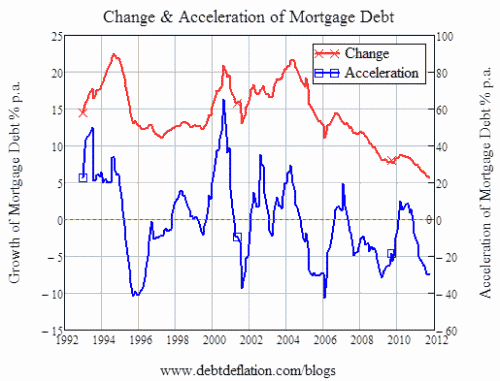
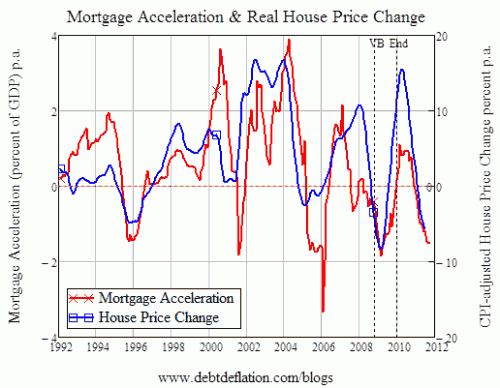
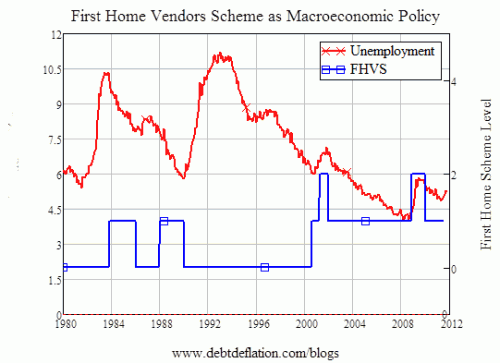
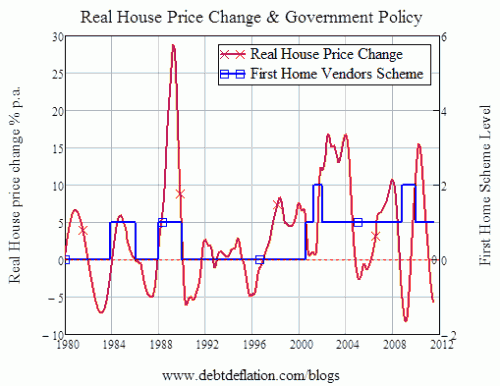
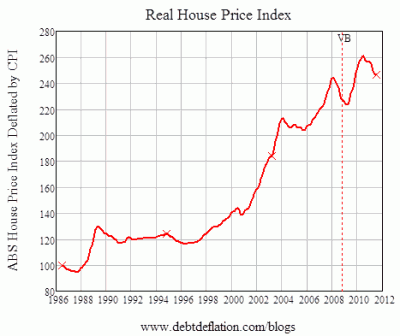
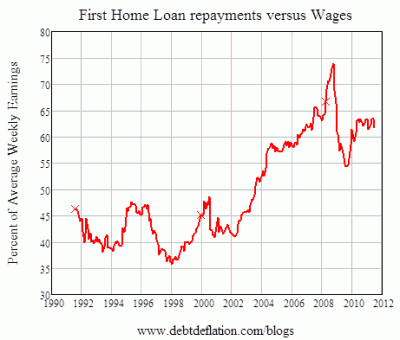
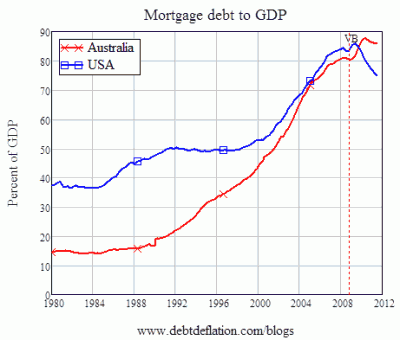
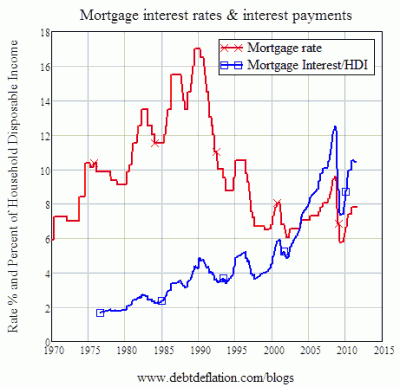
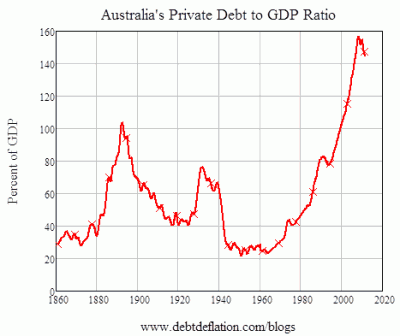
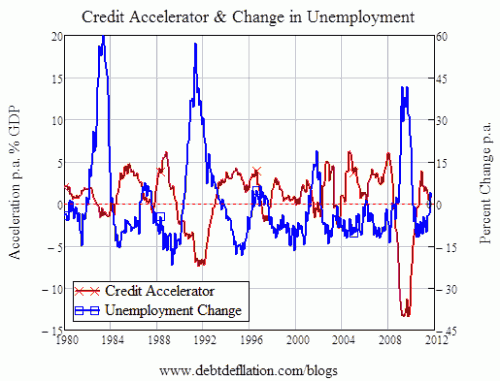
Australian Residential property is a massive bubble that will crush the local economy when it strikes. I have been following Aussie property for the last three years and it was over priced then. Quite frankly I am surprised that it has been allowed to grow so much. The real problem is that the mortgage market is dominated by the big three Australian banks and they are themselves dependant on Chinese money. While the commodity boom insulated the Australian economy during the financial crisis it does not mean that they are immune. In the medium term the Chinese will finish their commodity stockpiling and that will take the wind out of the Australian exports.
What needs to happen is that banks are banned from residential mortgages. There needs to be lending by mutual savings institutions along the lines of British building societies, but who are excluded from wholesale markets. This would restrict lending to a level of savings that they have accumulated. If it were restricted to individual savings it would not be able to inflate bubbles so aggressively if they were restrained by the level of savings. If the consumer could not save then the power to inflate the residential property bubble would evaporate. This would maintain the savings rate which has fallen in every country with a property bubble. By killing any prospect for massive property gains, and losses it would encourage savings and eliminate the impact of a credit event.
In the immediate future the RBA needs to concentrate on restricting overall credit growth to manageable levels. It is far to easy for any government to rely on a credit bubble to get the government out of any fiscal constraint. That only ends up in creating problems somewhere down the line.